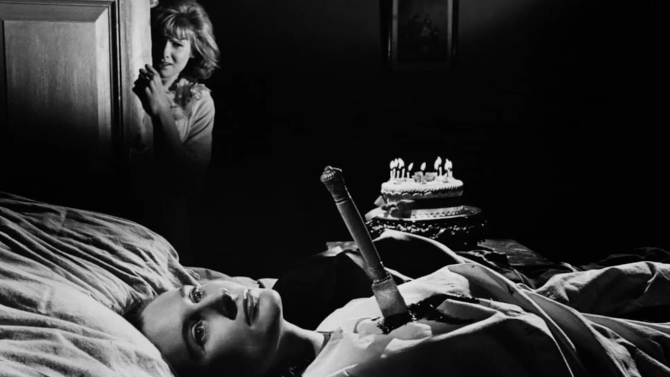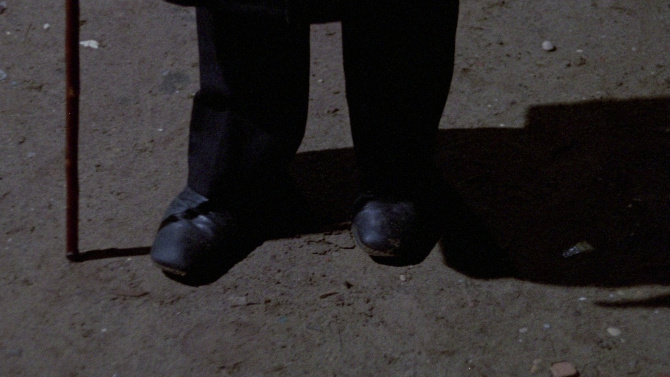
Murder ‘Mystery’
Sometimes a movie just doesn’t fit perfectly within its own genre... going against a few of the tropes that define what something is, all while hitting enough of them to still be what it is – confusing! That’s the case with this latter-day Italian giallo, Mystère... sometimes better known by its English title Dagger Eyes (1983). Co-written and directed by Carlo Vanzina, the film opens with a rather impressive, though more crime inspired assassination in Rome... resembling the real life John F. Kennedy car killing. It will start a chain reaction of murders that will rock the Eternal City.
-

Murder ‘Mystery’
MystèreMay 19, 2025Sometimes a movie just doesn’t fit perfectly within its own genre... going against a few of the tropes that define what something is, all while hitting enough of them to still be what it is – confusing! That’s the case with this latter-day Italian giallo, Mystère... sometimes better known by its English title Dagger Eyes (1983). Co-written and directed by Carlo Vanzina, the film opens with a rather impressive, though more crime inspired assassination in Rome... resembling the real life John F. Kennedy car killing. It will start a chain reaction of murders that will rock the Eternal City.
-

A Different Type of Photobomb
DeliriumApril 8, 2025Some might know that icon Mario Bava is often considered to be the first filmmaker to make a giallo with 1963's The Girl Who Knew Too Much... though unless you’re a big fan of the genre, many will probably not know that his son, Lamberto Bava, continued on with the gialli tradition well past its heyday in the early 1970s – releasing a number of horror tinged mystery thrillers, including today’s Delirium (1987)... sometimes also known as The Photo of Gioia. Welcome to what very well could be the Italian rival of Hugh Hefner’s Playboy, fluffily called Pussycat – a high end nudie magazine that brings some class (and a bit of kitsch) to artistic nude photography. Run by former supermodel Gloria (Serena Grandi), she inherited the business when her husband tragically died.
-

Brave the Elements
Decision to LeaveMarch 10, 2025Park Chan-wook has never hidden the fact that he is a huge fan of Alfred Hitchcock – frequently highlighting Vertigo as the movie that got him into film making. Like many before him, perhaps most notably Brian De Palma, he has found clever ways to integrate influences from The Master of Suspense within his own work, the easiest comparison being Stoker... a loose remake of Shadow of a Doubt. But his most recent feature, Decision to Leave (2022), which he co-writes and directs, might even be more so – though crafted so subtly that you really need to know your Hitchcockian filmography to see where he is pulling from. Originally getting the idea from the song “Mist” by Jung Hoon Hee and Song Chang-sik, which fuses quite nicely with the above quotation from Confucius, this mystery crime thriller flits between the always mist filled skies of seaside Ipo and the mountainous city of Busan. Though insomniac detective Jang Hae-joon (Park Hae-il) resides in the former with his wife Jeong-ahn (Lee Jung-hyun), he lives six days a week in the latter – a place that he has moved to for his job.
-

Finishing School
Naked You DieFebruary 18, 2025With its rather edgy, alluring title, 1968's Naked You Die (also known as The Young, the Evil and the Savage, as well as Schoolgirl Killer), you’d think you are in for a highly controversial giallo, but, as this dates from the 60s, a few years prior to when this style of film started pushing the boundaries of violence and sex, you’re actually in for a slightly more traditional murder mystery compared to what the title might suggest. After an unknown piece of luggage in the form of a giant, heavy trunk arrives at St. Hilda’s College (which is basically a posh boarding school for young women) along with a few new staff members, including husky voiced, goth like science teacher Mrs. Clay (Betty Low) and ultra athletic gym teacher and swim instructor Di Brazzi (Giovanni Di Benedetto), things turn unexpectedly murderous rather quickly.
-

Night Terrors
NightmareOctober 17, 2024Unlike most other memorable Hammer horror movies, the 1964 mystery thriller Nightmare, directed by Freddie Francis (perhaps better known as the cinematographer of films like David Lynch’s The Elephant Man and Martin Scorsese’s Cape Fear) eliminates all of the monsters for an old fashioned quasi ghost story... the piece deserving to be remembered up there with those Hammer horror films centered on vampires, resurrected corpses, and lycanthropes. Shot in shadowy black and white, the story follows struggling seventeen year old Janet (Jennie Linden), who is currently away from home living at a finishing school for girls.
-

The Case of the Cane Mutiny
Death Carries a CaneAugust 31, 2024Don’t get the wrong idea... the 1973 giallo Death Carries a Cane, co-written and directed by Maurizio Pradeaux, may make it sound like the grim reaper-like killer at the centre of all the carnage is simply some feeble hop-a-long struggling to meander the streets of Italy, but that may not be the case when you hear some of the other titles that this film has been gifted for different markets or releases: Dance Steps on the Edge of a Razor, The Tormentor, Maniac at Large, The Night of the Rolling Heads, and Devil Blade... perhaps it’s a bit more ominous sounding now. Poor Kitty (Nieves Navarro; aka Susan Scott) is at the right place at the wrong time... showing her visiting parents some of the tourist sites in Rome, she just so happens to be looking through some pay-for-use binoculars on a hilltop when she witnesses the murder of a young woman (through a house window) by a silhouetted assailant wearing a black hat, overcoat and stylish sunglasses who has a bit of a hobble.
